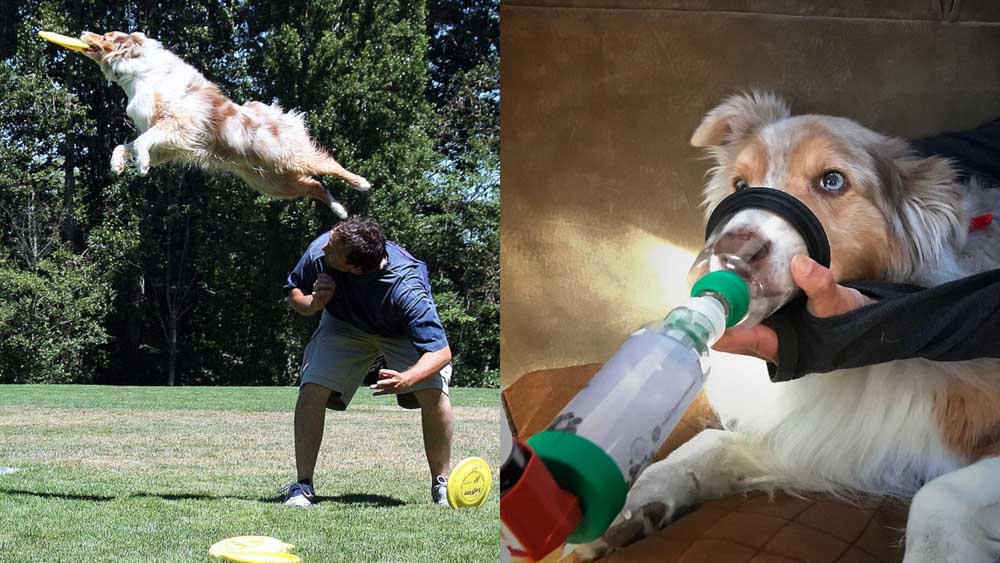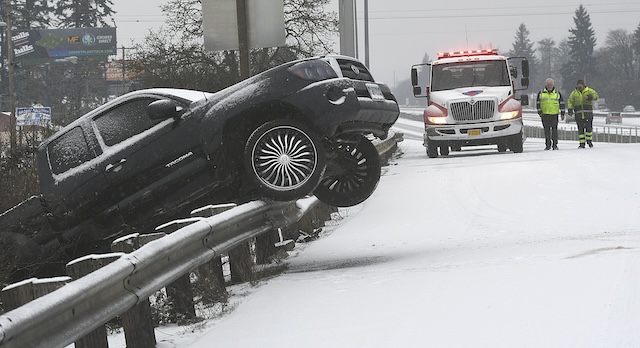Animal experts caution that wildfire smoke can affect pets, too
Published 2:00 pm Thursday, July 27, 2023

- Mesa, Lynne Ouchida's dog, liked to stay active and played disc golf with his owners. When the smoke rolled in during the Medford fires in 2020, his chronic bronchitis flared up making him need extra medical attention.
The smoky haze that lingered over Bend on Monday and Tuesday brought back hard memories for Lynne Ouchida.
In 2020, the smoke from wildfires burning across the state blanketed various areas in Oregon. The air quality index in Bend broke a record by reading at 500 on Sept. 12, The Bulletin reported.
Levels that read over 300 are hazardous, not only to humans but to animals as well. Ouchida, spokesperson for the Humane Society of Central Oregon, saw the impacts of this when her Australian shepherd, Mesa, started gagging, coughing and seemed to have lower energy levels back in 2020.
“He was hot, panting and had a reduced appetite,” Ouchida said. “This is a dog who had a really healthy appetite and drank. All of those normal signs decreased with the onset of wildfire smoke, and that was even keeping him indoors.”
The Humane Society urges residents to not only think about themselves when wildfire smoke starts to roll in, but their furry friends too, and that goes for livestock as well. Ouchida hopes pet owners are mindful during wildfire season, and urges owners of pets with complicated health histories.
She said Mesa was an active dog that loved to play disc golf. As he got older, he was treated for chronic bronchitis. Without access to proper medications and care, things could have been a lot worse when the smoke started to impact his health.
“I think for the most part, people who have a healthy pet, may be just seeing some eye irritation, rubbing of the eyes, some nasal discharge, and things like that,” Ouchida said. “I think it’s the animals that have heart and lung conditions that this is going to impact the most, as well as senior animals.”
How to keep animals safe?
Animals are the safest when staying indoors with the windows shut. Ouchida said if owners are able to afford an air purifier, running that in the background helps as well.
Some pet owners have come to Ouchida asking for advice for pets that usually stay outdoors or aren’t able to be left in the house unattended. She said the Humane Society can help with that.
“You can always rent a crate from us for $5 a month,” Ouchida said. “It’s a great way to keep your home safe as well as your pets safe while they’re inside and not breathing the air quality that we’ve had the last few days.”
While staying indoors is the best way to keep from breathing in smoke, Ouchida recognizes that animals still need to relieve themselves. She recommends looking at the air quality index to gauge when the levels might be lower for a brisk walk. The Oregon Department of Environmental Quality’s statewide air quality index readings can be found at https://aqi.oregon.gov/
“Today with the air quality apps, you can certainly plan your times for exercise because you’ll be able to see in that 24 hour period where the air quality might improve,” Ouchida said. “That’s maybe the time to plan. It may be 4 a.m., but maybe that’s the best time to plan for a quick walk or just getting them outside.”
Pets and wildfire safety:
Wildfire evacuations are a stressful event not only for humans but for animals, too. Preparing an evacuation kit for a pet is the first step to being prepared.
The American Red Cross Association has a checklist on its website at www.redcross.org/get-help/how-to-prepare-for-emergencies.
Some items include:
- Sturdy leashes, harnesses and/or carriers
- Food, drinking water and bowls. (Don’t forget a manual can opener if the pet eats canned food.)
- Cat litter/pan
- Medications and copies of medical records in a waterproof container
- A first aid kit.
Ouchida said she has encountered a fair share of stressed and injured animals during evacuation protocols and wildfires.
Keeping a photo of your pet along with any documentation to prove the animal is yours is also recommended for your kit.
“A lot of the animals that we received, people lost them as they were loading up their cars. They took off and got into flight mode, or particularly with cats they would hide underneath beds and then people couldn’t get them out in time and had to evacuate without them,” Ouchida said. “We want people to be prepared.”
Ouchida recommends putting pets in a kennel or safe room while packing up to leave to prevent the animals from running away.
“Keep your pets, your cats or dogs locked, or secure in an interior because if you are stressed and you’re in a panic and you’re starting to load items into your car to be prepared to evacuate, that’s when animals get lost,” she said. “They’re feeling the stress on the home and the doors are left open.”
Much like pets, the humane society recommends that livestock owners keep the animals in mind when smoke starts to effect the air quality.
Here are a few tips:
- Limit exercise especially if it requires substantial increase of airflow in and out of the lungs.
- Fresh water should be provided near feeding areas.
- Using low-dust or dust-free feeds will limit dust exposure. Sprinkling or misting the livestock holding area can also improve living conditions.
- 4 to 6 weeks is the recommended recuperating time after the air quality returns to normal. Handling, moving, or transporting livestock during this time may delay healing and compromise the animals’ performance.
Wildfire evacuation: Bend officials outline what you need to know








